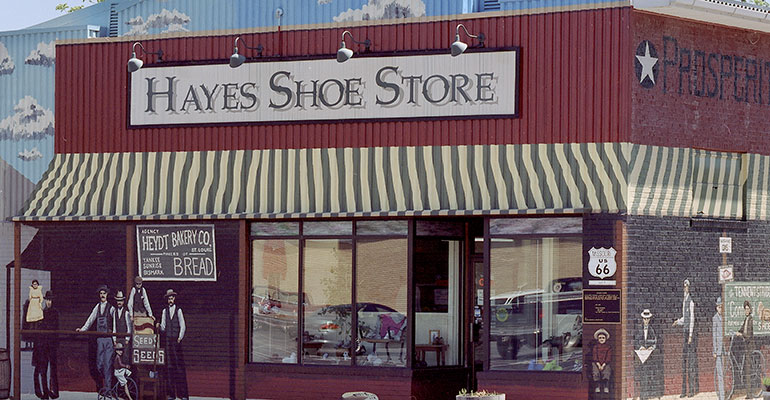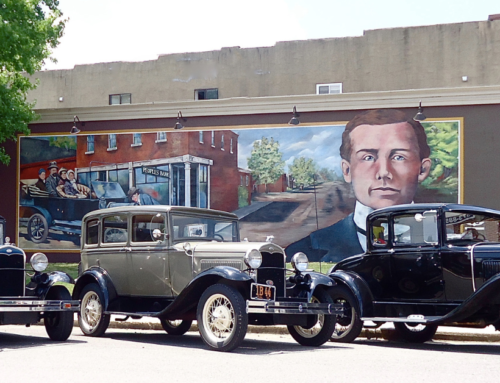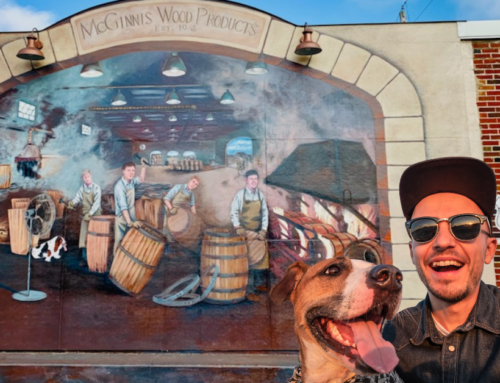
Prosperity Corner
103 S Smith St.
Cuba, MO
When Jeff Bouse, owner of Hayes Shoe Store on Route 66 in Cuba, Missouri decided to expand his line to Clark’s shoes in 2003, he probably saw this as an innovation for his customers. Little did he know, that an even bigger innovation involving both the past and the future of his business would soon take place.
Viva Cuba approached Bouse with an expansive program to place an outdoor mural on the building, which fronts historic Route 66. The mural was to be of a business enterprise from the past called Prosperity Corner, which originally occupied the site of the shoe store in the early 1900s. It was a site where people gathered to talk and do business at H.H. Tieman’s General Merchandise store. Scenes from this period and location would be painted on the outside of Hayes Shoe Store on both exposed sides of the building. With a leap of faith, Jeff Bouse agreed to become a part of the mural program, which would transform his building and become a part of the revitalization project for the Cuba Historic District.
Signs and an awning came down, tuck-pointing took place, and the brick store was primed white. In July, Artist Kelly Polling from Chillicothe, Missouri took up residence outside the building from early morning into the evening. He scaled ladders and scaffolding. The white walls were covered with large blocks of paint. Awnings were painted on the building. Or were they real awnings? It was hard to tell. Real windows were painted over, and windows were painted where there weren’t any. Business signs from the 1900s appeared on the walls. Characters from the 1900s strolled into the scene. At times, it was difficult to decide what was real and what was part of this scene of time travel. Slowly, day-by-day, the artist imprinted Hayes Shoe Store with these scenes from an earlier time. Prosperity Corner returned to its origin.
In the early 1900s, the building on this corner was known as Prosperity Corner. While we think of prosperity as a favorable attribute to be associated with a business, when we investigate the “rest of the story,” we find a darker side to the tale.
In the early 1900s, Cuba’s Prosperity Corner was a bustling scene as this early picture shows. The building on the corner of Smith and W. Washington was the home of H.H. Tieman’s General Merchandise store and a focal point for local folks to gather, do business, and pass the time of day. Today, Hayes Shoe sits on this corner, which makes the store a fitting location for Viva Cuba’s mural depicting aspects of this busy 1900s scene. The wraparound mural on the Hayes Shoe Store is part of Viva Cuba’s in-kind donations for the Community Development Grant for improving the Historic Business District.
Proprietor Tieman Disappears
However, there’s the rest of the story behind the mural, which brought puzzlement to the existing prosperity of the corner in 1910 when its proprietor went missing on a business trip.
Henry Herman Tieman was born in Hanover, Germany in 1842 and came to the United States in 1856. After living in various places and starting several businesses, Tiemann moved to Cuba and owned a canning business and mercantile store. He married Martha Blankenship and had seven children.
According to a May, 1910 article in the Shreveport Times, one day in 1910, Tieman went to the bank and cashed a check for $10. He left Cuba to deliver canned goods to the Joplin area. However, he never returned and after advertising for his whereabouts and various investigations, foul play was suspected, and he was assumed dead by friends and family.
Tieman Located in Shreveport
Then Mr. Tieman’s wife received an unexpected copy of the Shreveport Times in the mail. She recognized the address as the handwriting of her missing husband. She went to James N. Smith of the Cuba Bank with her story. Carrying a picture of Tieman, Smith departed for Shreveport. Louisiana.
When he arrived, he began to show the picture of the missing man and asked if anyone had seen him. A merchant told him that it was the man who sold him the Times every morning. According to the Times article, when Mr. Smith later saw the paper seller, he immediately recognized him as Tieman. When Tieman saw Smith, he said,”Hello, Smith! What are you doing here?”
Then Tieman told about his hardships of the last two months. He said that he had intended to be thought dead because of his business worries. He said he felt his wife was in comfortable circumstances, and he would start a new life. He had endured hardships getting to Shreveport because he had no money, but he refused to return home. He said health problems and business worries caused him to leave Cuba, and he would not return. He had gone to the paper office upon arriving and asked to sell newspapers to make a living.
Therefore, the banker Smith had papers drawn up and notarized that would close up Tieman’s business. Smith stated that Tieman was worth about $12,000 with his mercantile business and a canning factory.
Later in 1912, Tieman wrote a letter to the editor of the Cuba Review on the occasion of his birthday. He discussed how Shreveport was prospering and said that he would write on his next birthday. The thread of Tieman’s story was eventually lost but in the cemetery there is a stone inscribed with the name Henry Herman Tieman 1842-1921.
So while the Prosperity Corner was a hub of business energy in the 1900s, it did not serve its eccentric owner well. However, this only adds to the mystique of Prosperity Corner. This early saga associated with what would become Route 66 is colorful background for this mural painted in 2003. Now Bouse and his staff, as well as expertly dealing with their customers’ shoe needs, answer questions about the mural. People stand outside staring at the building. People stop to take pictures. As drivers pass by, they often do a double take at the new facade. Many times they even come inside to buy shoes.
If you are in Cuba, Missouri along Route 66, you, too, are invited to step into this scene from an earlier time at Hayes Shoe Store. The store’s name is on the front of the building. But be careful; you may come to wonder if it’s a mural or just a warp in time.
This article is based on information presented to the Crawford County Historical Society by J.I. Breuer in a paper entitled “The Rise and Fall of ‘Prosperity Corner’,” and on an article from the May, 1910 Shreveport Times.






